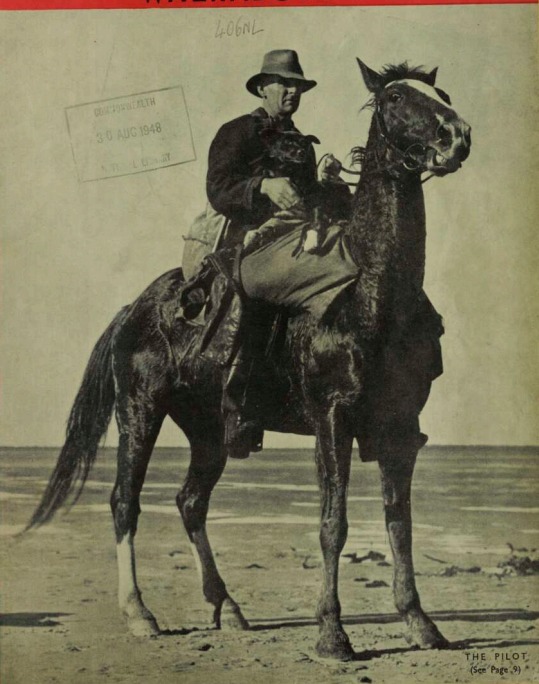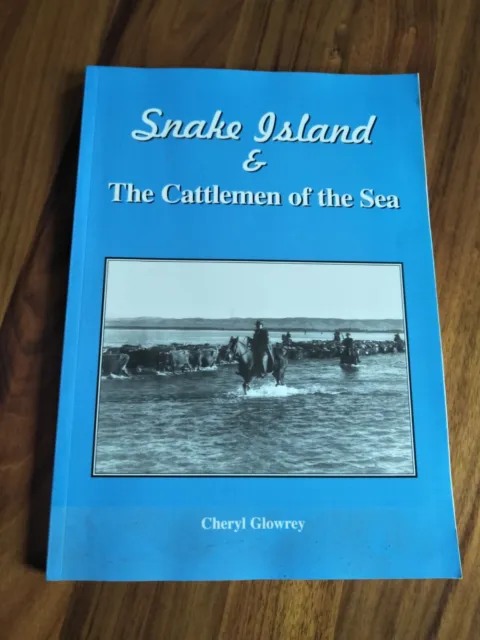Snake Island Droving

Waler Data Base @ Facebook, March 2024. Image: Roy James the Pilot… photographed by Ray Bean… James is mounted on ‘Journal’, a well-known horse in the Welshpool district, which he has used in this droving job for the past eleven years. Walkabout, 1st September, 1948.
Droving in the sea… Snake Island is off Port Welshpool, Gippsland, Victoria. From 1908 dairy farmers agisted cattle there seasonally.
The cattle have to be swum across a dangerous bit of water called Lewis Channel. First they get to Little Snake Island, walk across that, then go into another channel to swim to the bigger Snake Island – some 3,450 hectares.
Due to sandworms a lot of the sea floor is quicksand. Several horsemen are needed to keep the cattle swimming and wading across the only safe crossing route – which is narrow. Timing must be perfect to work with low tide.
The man in charge, chosen from the regulars, was called the Pilot. He decided when it was safe to cross and guided the men and cattle. The cattlemen voted for the pilot each year; he was paid a per head fee (usually a shilling) to get the cattle across, and later, back again.
From 1859 there was a manned lighthouse on Snake Island, accessed by boat. Samuel Smith was one of the legendary lighthouse keepers there. It may be automatic now, someone may know; it was abandoned by 1888. The cattlemen built little huts and needed to take over all they needed for an overnight camp as there was no-one there to help them on arrival, usually they carried supplies on their horse. Wild pigs and deer ran rampant at one stage, being left by a lighthouse keeper, and horsemen went over in the 1880’s and shot over 200 wild pigs and many deer. In those times the whole island was leased for grazing.
Interesting to note that during a visit in 1888, people who went there camping, knee-deep in lush vegetation at times saw not a single snake – the island being named for its shape, not its inhabitants!
One year about seventy cattle strayed off course on the swim across – the tide was coming in – despite frantic efforts the cattle got into quicksand and had to be abandoned at the last minute – swept away as the eight foot tide ripped in.
One trip, Roy James, the pilot in the feature photo for this post, decided at the last minute not to cross. They took the nine hundred cattle back to nearby yards when a giant hailstorm hit. Had they been in the water, cattle and horses would probably have panicked, causing disaster. They crossed safely another day. The islands are in Bass Strait, known for wild weather, so the pilot is critical.
Having several horsemen not only kept the cattle together, it ensured someone could be picked up if they came off their horse. For 30 years Mr T. Finlay was the pilot. From 1940 it was Roy James.
This has been a success story between Parks Victoria and local traditional use, for almost a century. The whole island is a reserve so flora and fauna is protected. The Snake Island Cattleman’s Association arranges agistment and liaises with Parks. They have a permit to use half of the island for cattle agistment for part of the year. Over the years they’ve improved the overnight huts, yards, fences and put in good tracks. Maintenance of all these is a condition of their permit; they have plenty of willing volunteers. They’re also allowed to take a small number of visitors over on horses when they go to check on the cattle.
There are feral hog deer on the island, and once a year Parks holds a ballot to randomly select hunters to go there for a brief time to reduce numbers. The happy chappies chosen go over and back by boat.

While we decry arial shooting which is cruel, and the wholesale slaughter of brumbies now happening in the Snowies, traumatising indeed, this is a great example of Parks and traditional uses existing peacefully side by side, benefitting both – grazing alleviates fire hazard and controls introduced grasses (conservation grazing). This co-operation creates a lot of goodwill and much good work is done by the volunteers, who help Parks at times with many tasks and keep an eye on things.
A book is available for sale in the Port Welshpool Museum: Snake Island & The Cattlemen of The Sea by Cheryl Glowrey. And there is also a tremendous old film clip of the crossing made in 1947.